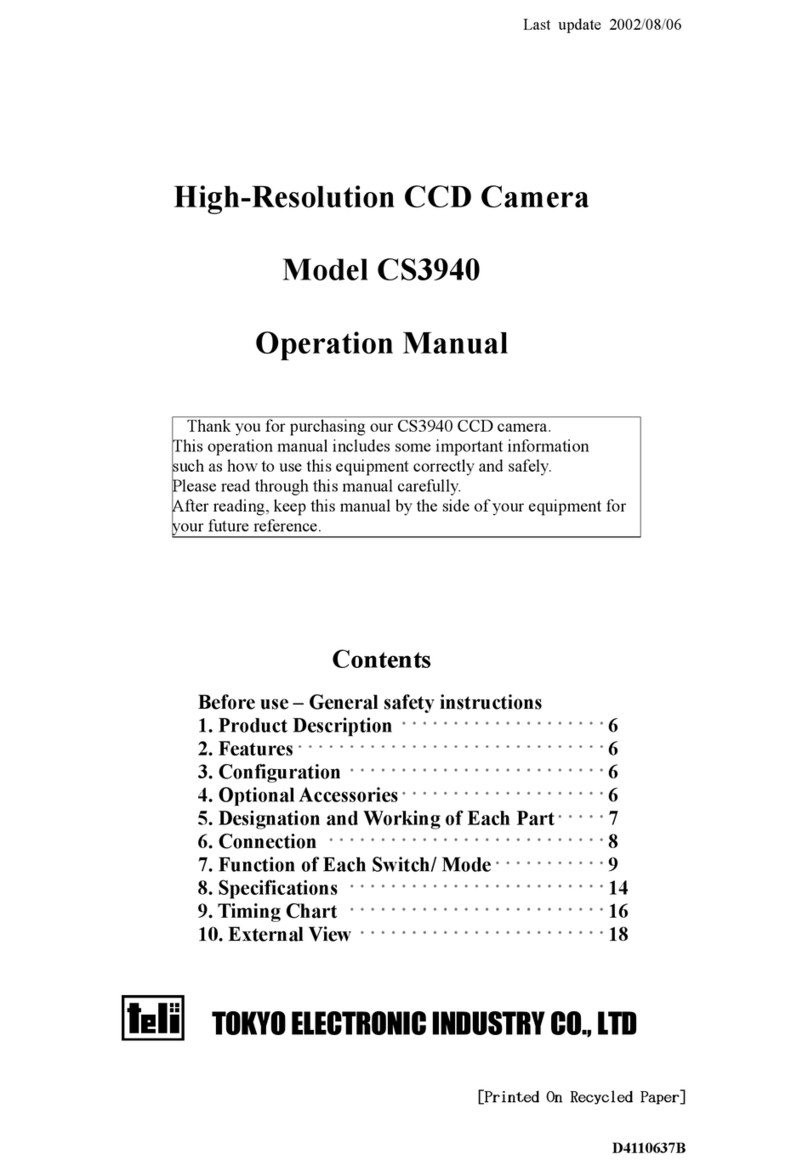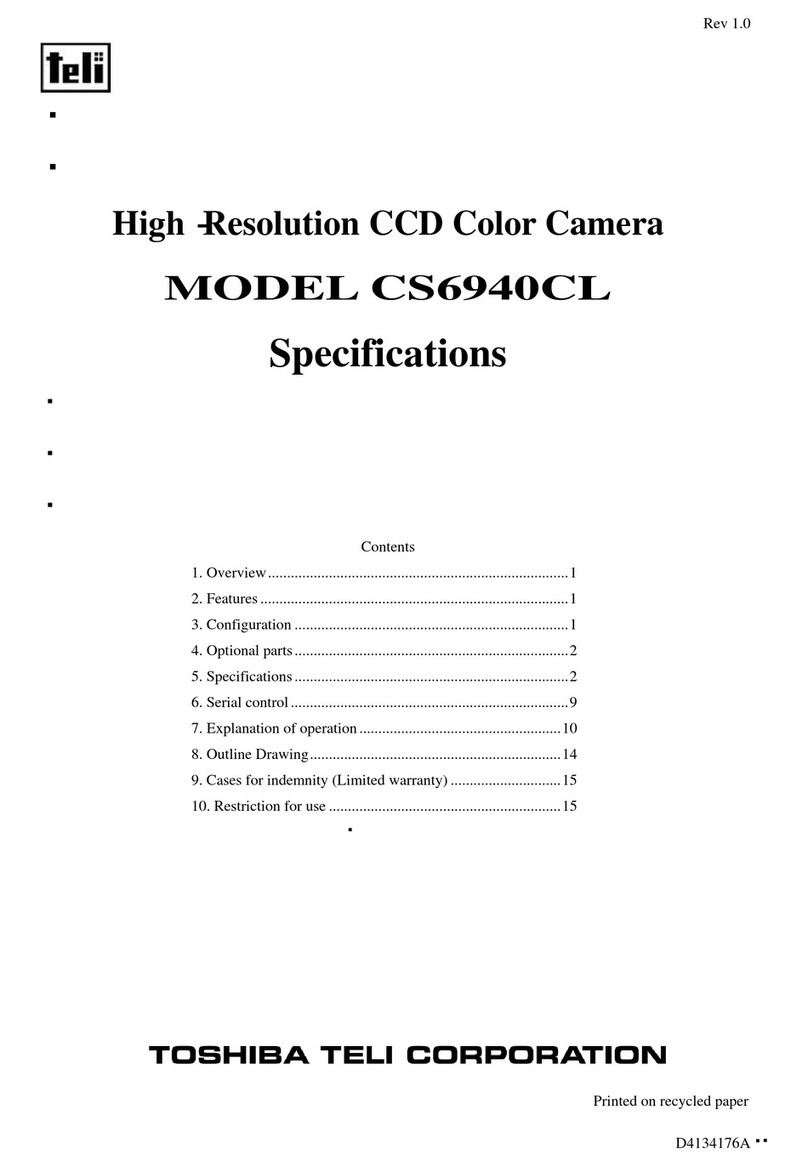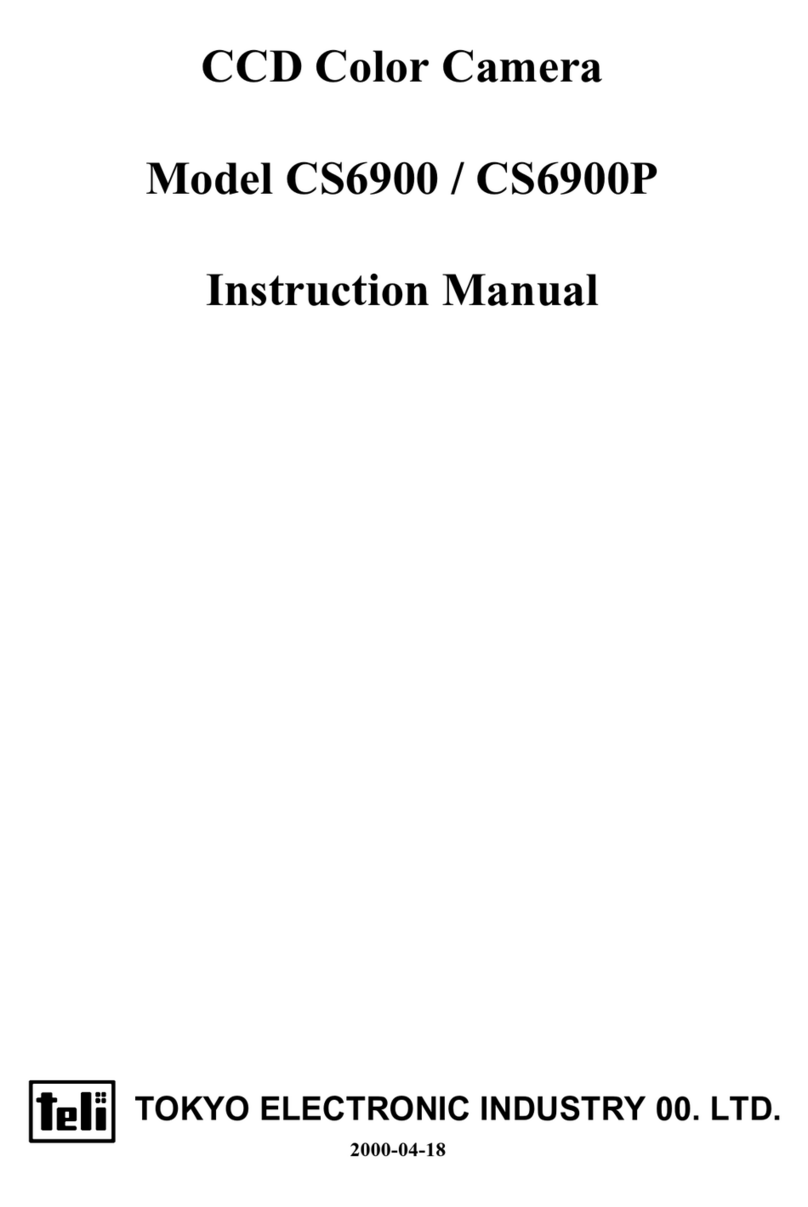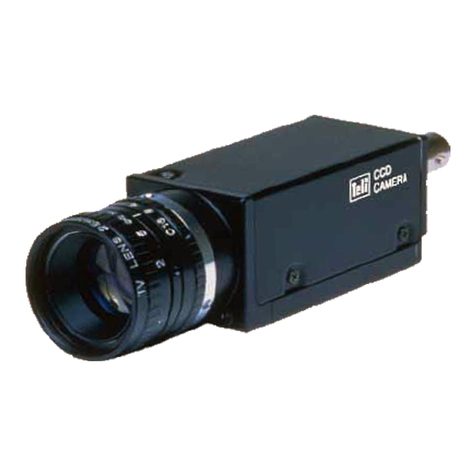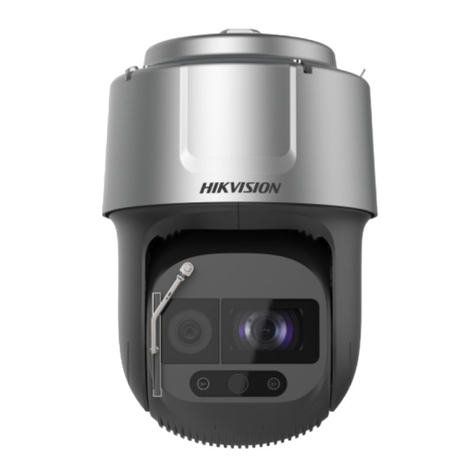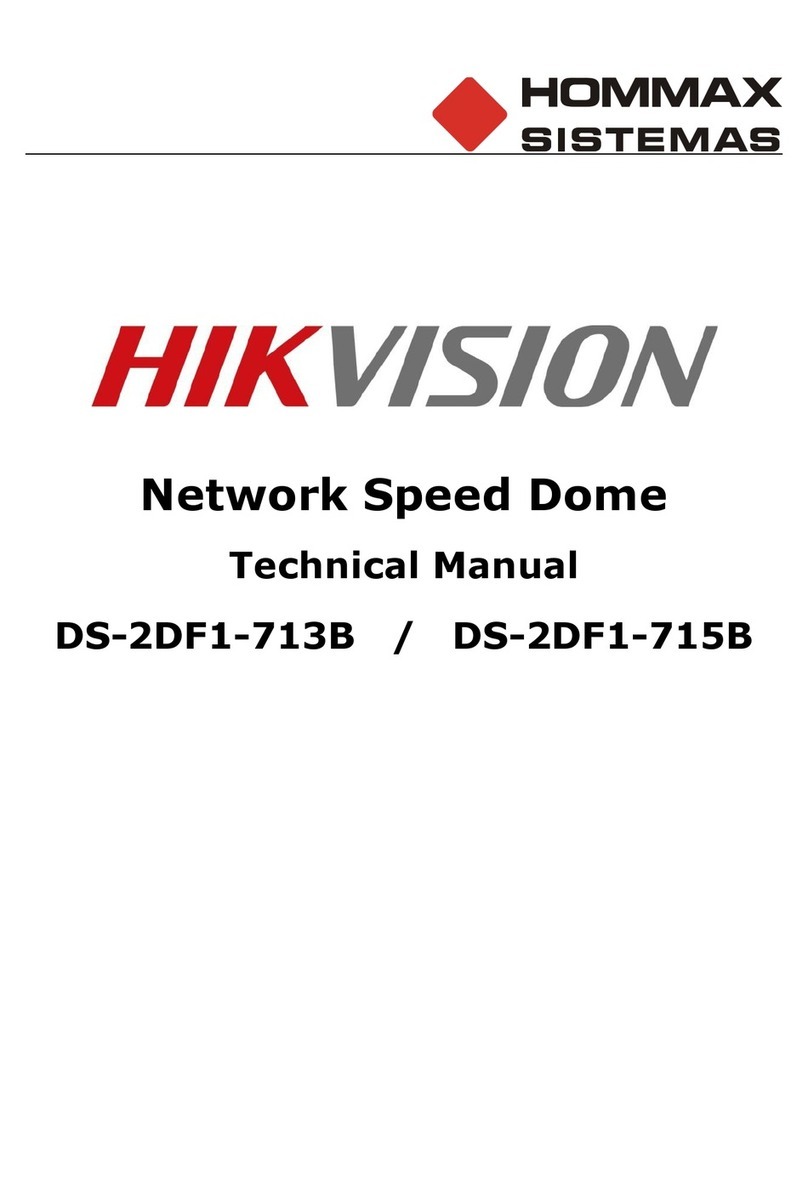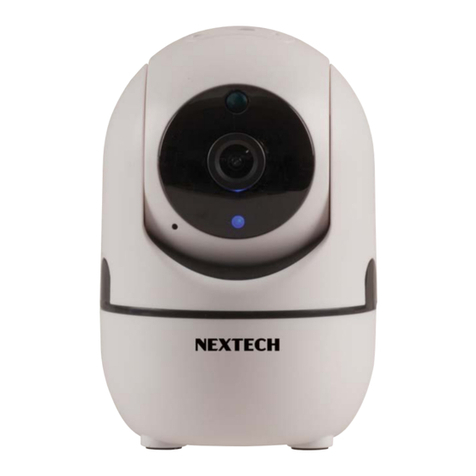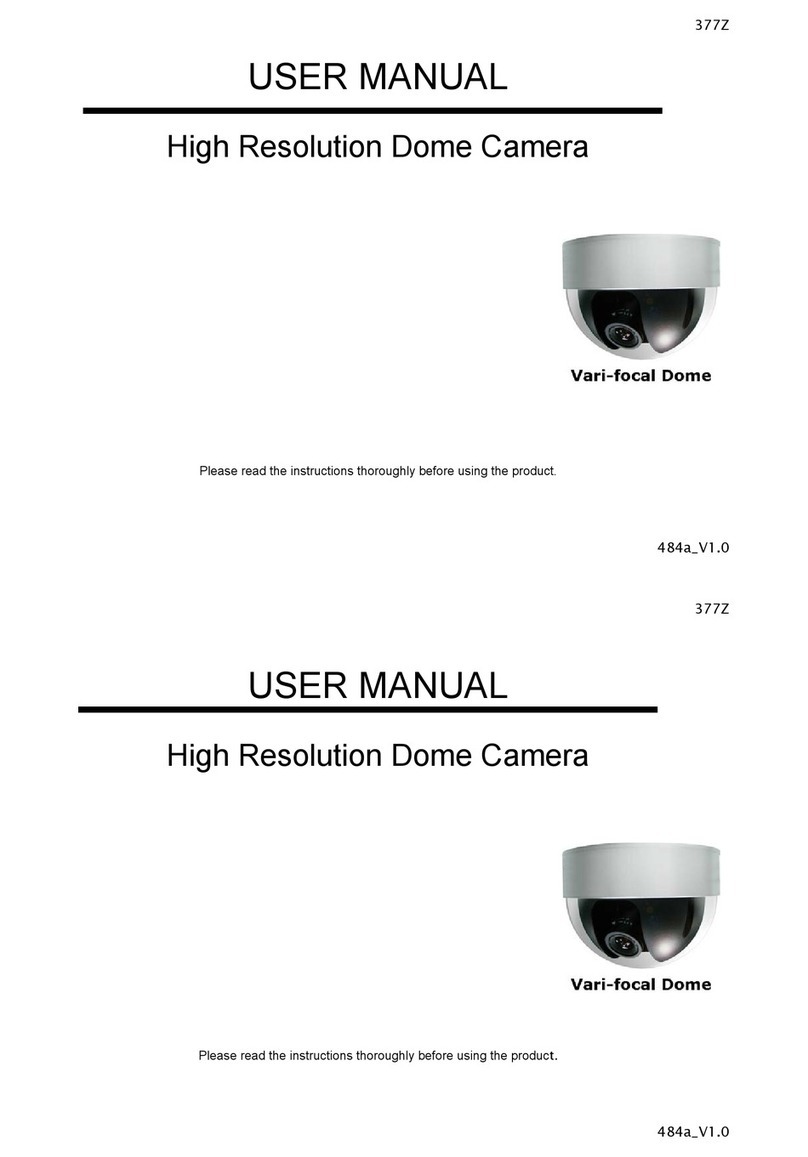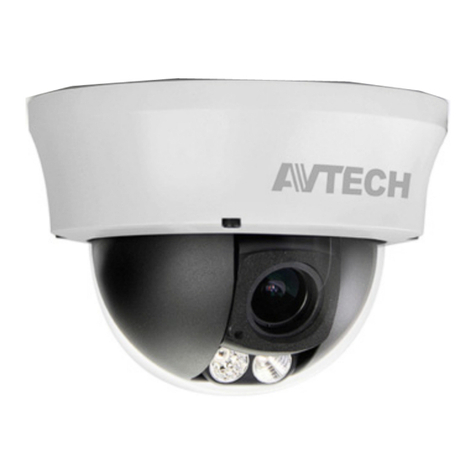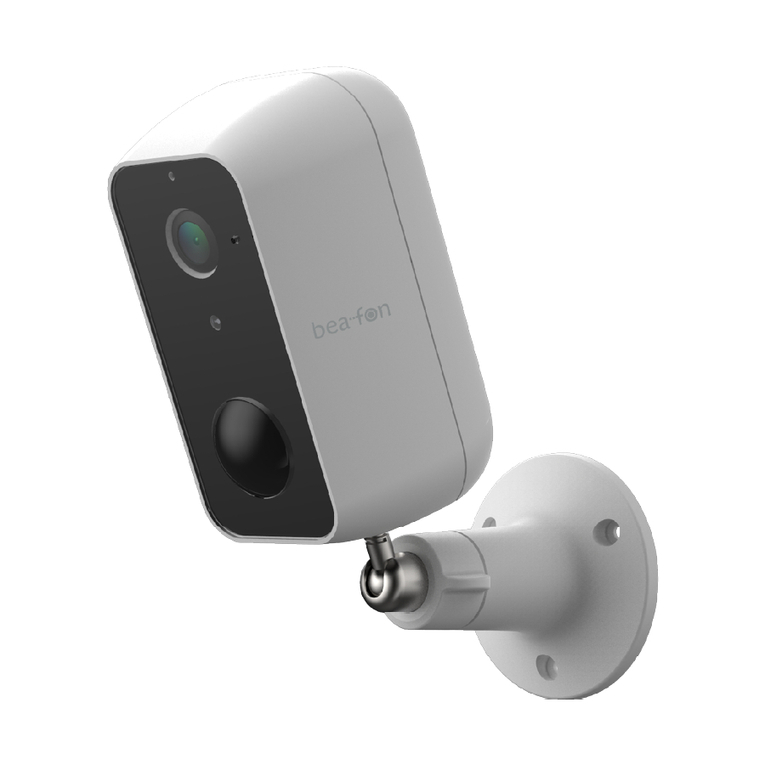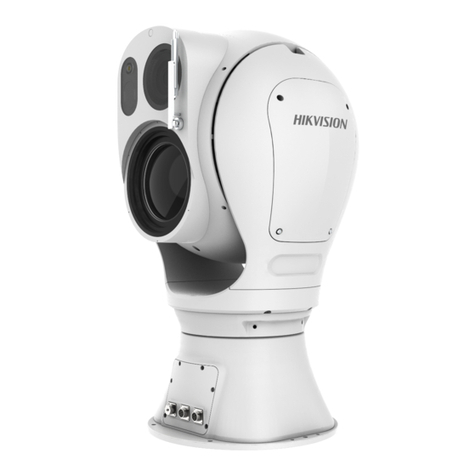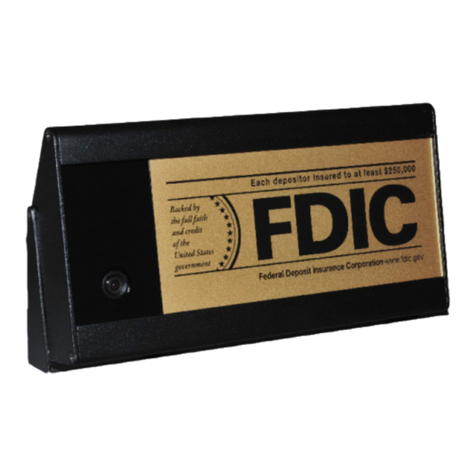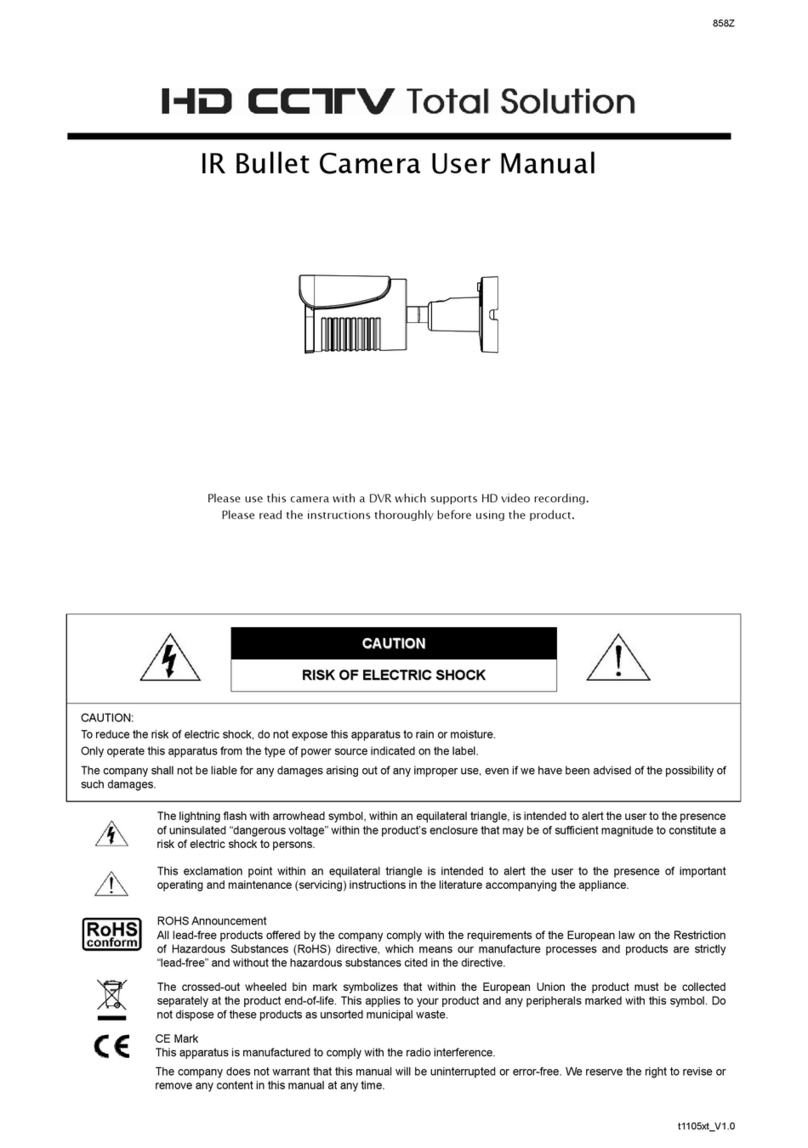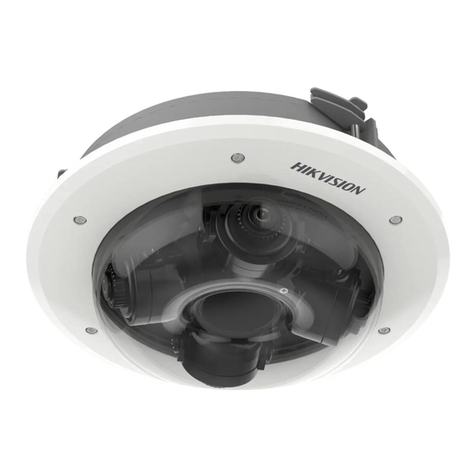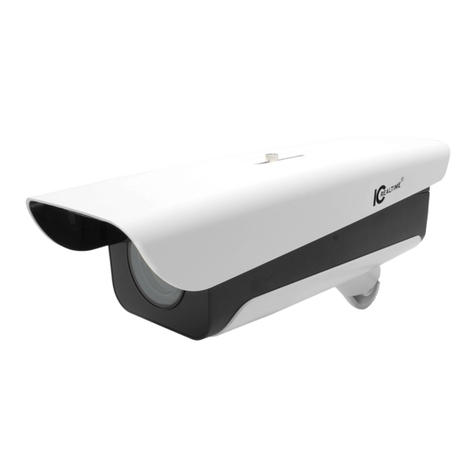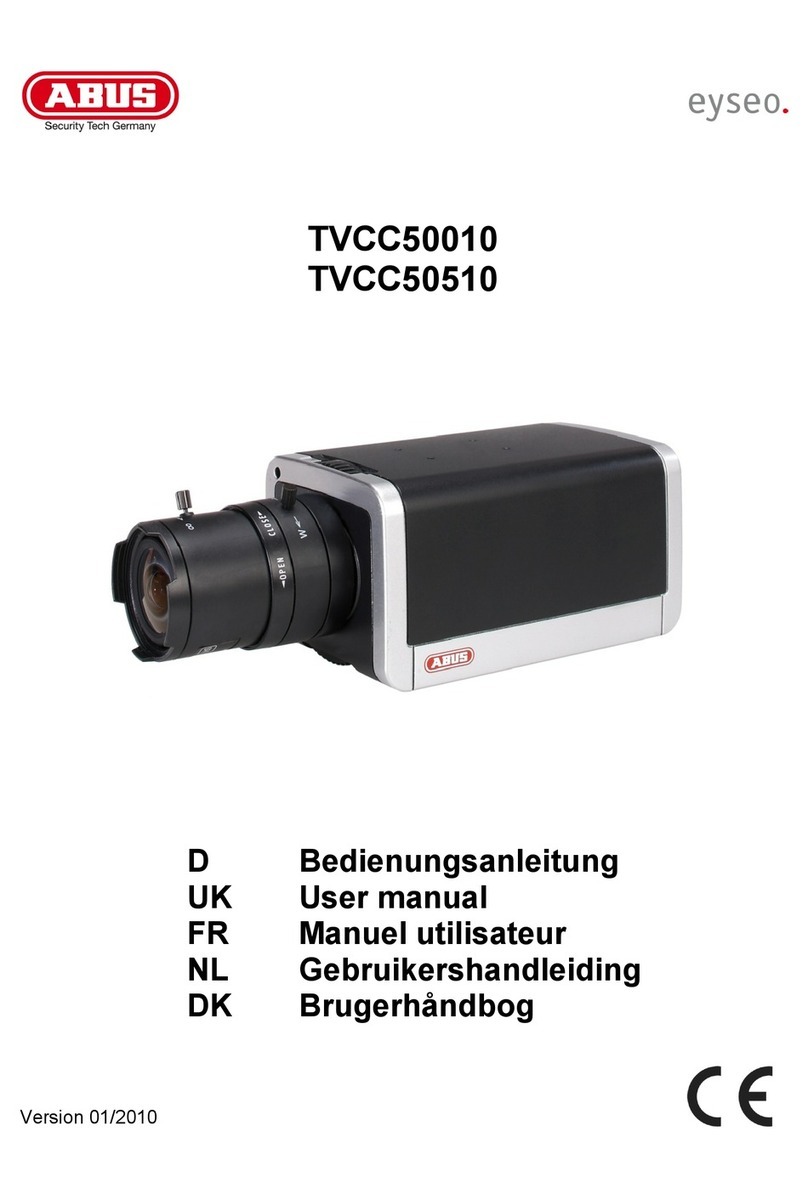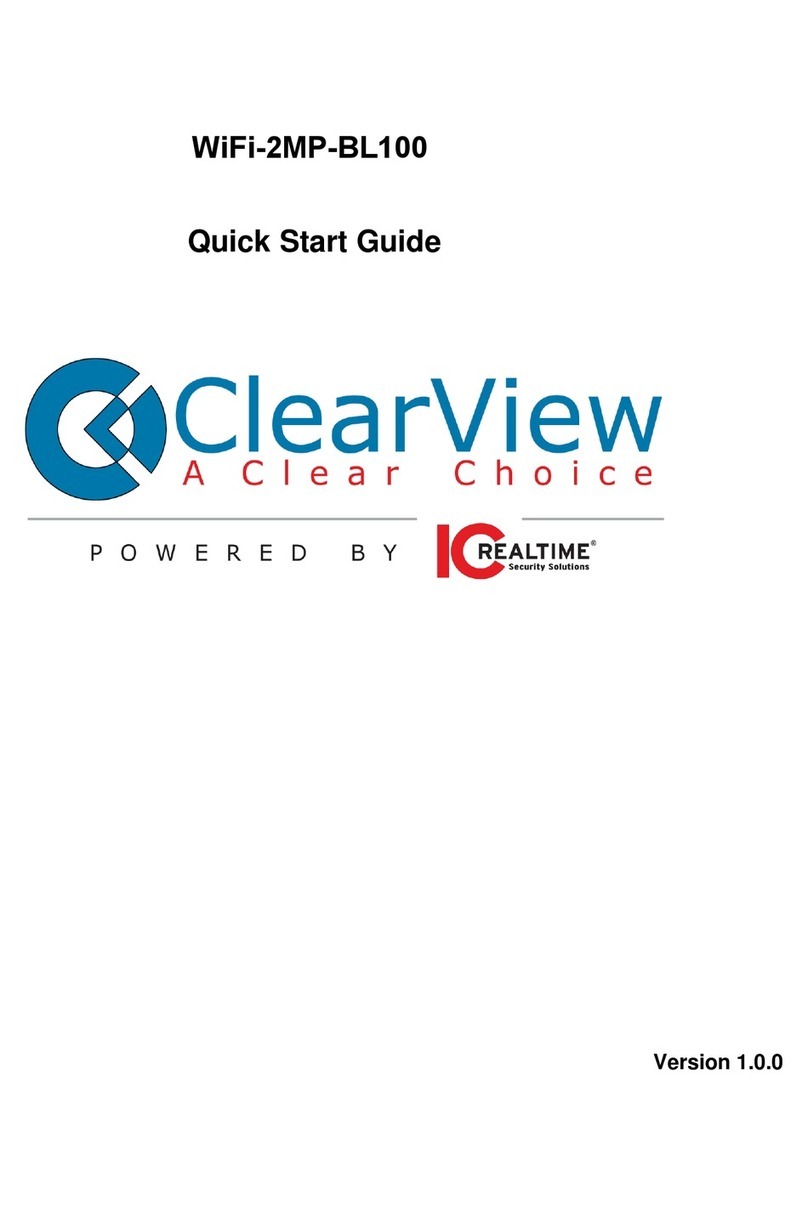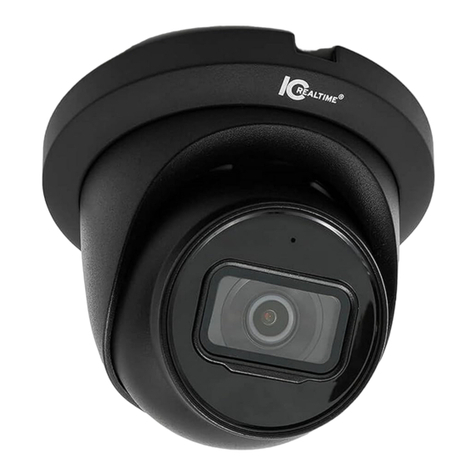Teli CS3920 User manual

Version 1.3
High-resolution CCD Camera
Model CS3920
Operation Manual
Enter the blank below Product Serial Number, which is found on bottom/rear
chassis of your camera. Keep this number for your record.
Model No. CS3920
Serial No.
TOKYO ELECTRONIC INDUSTRY CO., LTD.
2000-04-07

Thank you for purchasing our CS3920 B/W CCD camera.
This operation manual contains some important information such as how to use
this equipment correctly and safely. Please read through this manual carefully.
After reading, keep this manual by the side of your equipment for your future
reference.
CONTENTS
GENERAL SAFETY INSTRUCTIONS
1. PRODUCT DESCRIPTION 1
2. FEATURES 1
3. CONFIGURATION 1
4. OPTIONAL ACCESSORIES 1
5. DESIGNATIONS AND WORKINGS OF EACH PART 2
6. HOW TO MOUNT THE CAMERA 3
7. CONNECTION 3
8. SETTING 4
9. SPECIFICATIONS 6
10. TIMING CHART 7
11. EXTERNAL-VIEW DRAWING 13

BEFORE USING THE CAMERA ―GENERAL SAFETY INSTRUCTIONS
This Operation manual contains important information for the operator (user) and/or people
around him/her to avoid personal injuries, or property damages against him/her or people
around him/her by using this product correctly. Prior to use, read this operation manual
carefully to fully understand its instructions for correct use.
[Definition of markings]
The meaning of each mark used in this instruction manual is given below.
DANGER This mark warns the user that improper use, indicated with this mark, may
cause death or severe personal injuries against the user or people around
him/her.
CAUTION This mark warns the user that improper use, indicated with this mark, may
cause personal injuries (*1) or material damages (*2) against the user or
people around him/her.
Notes
*1 : Personal injuries mean wounds, burns, electric shocks, and others for which the person
injured need not to be hospitalized nor to be cared for the long term.
*2 : Material damages mean any direct or consequential damages related to property or material
loss.
This mark indicates what the user SHOULD NOT DO. The details of things which the user
should not do are described next to this mark.
This mark indicates what the user MUST DO. The details of things which the user must do
are described next to this mark.
This mark indicates that the user must be alert against a possible DANGER. The details of
the DANGER which the user must be aware of are described next to this mark.
This mark indicates that the user are given a CAUTION against possible hazards. The
details of the CAUTION which the user must be aware of are described next to this mark.
●Handling precautions
DANGER
If any overheating sign is observed, discontinue the use immediately.
In the event that smoke, smell, or any other overheating sign is observed, turn the power
switch of the system OFF immediately, and remove the camera cable from the camera
connector. Do NOT try to continue to use the camera. To do so in spite of clear signs of
malfunction invites a fire, an electric shock hazard, or a serious damage to the camera. In
such case, contact us or our dealer/distributor from which you purchased the camera for
repair service.
If any malfunctioning sign is observed, discontinue the use immediately.
Do NOT try to use the camera when it is malfunctioning. (Ex. No images on the
monitor) In the event of malfunction, turn the power switch of the system OFF
immediately, and remove the camera cable from the camera connector. In such case,
contact us or our dealer/distributor from which you purchased the camera for repair
service.
!
!
!

If any foreign object gets into the camera, discontinue the use immediately.
In the event that liquids, small particles, or any other foreign objects get into the camera,
do NOT try to continue to use the camera. To do so invites a fire or an electric shock
hazard. In that case, turn the power switch of the camera OFF immediately, and remove
the camera cable from the camera connector. After that, contact us or our
dealer/distributor from which you purchased the camera for repair service/technical
advice.
If any outer strong impact is given to the camera, discontinue the use immediately.
In the event that the camera is dropped onto the ground, or the cabinet of the camera is
damaged, turn the power switch of the system OFF immediately, and remove the camera
cable from the camera connector. Do NOT try to continue to use the camera. To do so
invites a fire or an electric shock hazard. In such case, contact us or our
dealer/distributor from which you purchased the camera for repair service.
Do NOT disassemble the camera.
Do NOT attempt to pull apart, repair, or modify the camera on your own. To do so might
lead to an irreparable breakdown / malfunction, or might invite an unexpected accident.
Contact us or the dealer/distributor from which you purchased the camera for
repair/modification.
Do NOT supply any power other than specified.
The camera is designed to work only under specified voltage. Do NOT attempt to drive
the camera with the power other than DC12V. Operating the camera under power other
than DC12V invites a fire or a electric shock hazard.
Do NOT place the camera unstably.
Do NOT place the system on an unstable table, sloped ground, etc.. Make sure that the
camera do not fall to prevent an accident.
Do NOT place any potentially-hazardous things on the camera.
Do NOT place any things on the camera which may, if it gets into the inside of the body,
damage the inner parts of the camera (such as a flower pot, glass, cosmetics, a container
filled with liquids or chemicals, as well as small metal parts, etc.). If tumbled, the liquids
inside the bottle, etc. may get into the system, causing a fire or an electric shock
accident.
Do NOT short-circuit signal outputs.
Avoid short-circuit of signal outputs. Otherwise it may cause damage to the camera. For
inspection of inner parts/circuits, adjustment, maintenance, contact us or the
dealer/distributor from which you purchased the camera.
Do NOT use the camera in a high-humidity environment.
Do NOT place the camera near a humidifier, or in other high-humidity environment.
To do so may cause a fire or an electric shock accident.
Do NOT expose the camera to direct sunlight, nor intensive heat.
Do not place the camera where it is exposed to direct sunlight, or in a higher temperature
than guaranteed (Over 40 degrees Celsius). To do so may cause the inner temperature of
the camera to go up, resulting in burning-down of inner parts, circuits or a fire accident.
Do NOT expose the camera to greasy fumes
Do NOT place the camera at the location where it is exposed to greasy fumes or steams,
or heavy dusts. To do so may cause the inner temperature of the camera to go up,
resulting in burning-down of inner parts/circuits or a fire accident.

CAUTION
Do NOT connect/disconnect connectors with power ON.
Before connecting/disconnecting connectors, make sure to check if the system is
powered OFF. Doing so with power ON may cause a damage or an electric shock
accident.
Do NOT give a strong shock/impact against the camera-head.
Avoid giving a strong shock against the camera head. The camera-head might be
damaged.
Do NOT pull/swing the cable forcefully.
Do not pull strongly the camera cable/camera-head nor swing it. The stress from pulling
or swinging may cause damage in the coating of the cable, or breaks in the inside wires.
In carrying the camera around, be sure to disconnect connection cables/lines beforehand.
Otherwise, the connection cable(s)/line(s) might be damaged, causing a fire or an
electric shock accident.
If the camera is operated in the electromagnetic field, there may be cases where beat
noises (vertical, horizontal, or oblique stripes) may appear in the video output. In that
case, take preventive measures on the electromagnetic-wave generating source so that
the camera do not receive the interference by the electromagnetic-wave. Take extra
precautions against electromagnetic-wave-interference if the camera is used with a
servomotor, inverter, or other electromagnetic-wave-generating equipment.
When the camera is not in use, put a lens or a lens-cap onto the camera head so that the
image pickup plane of CCD is protected from dust, foreign object, or other flaw-causing
object. If the glass plane (image pickup plane) gets dirty, clean it with a cotton swab.
When it needs to be cleaned with a cleaner, be sure NOT to use any organic solvent other
than ethyl alcohol. As a countermeasure against condensation, when the camera is
moved from a warm place to a cold place, take appropriate precautions to prevent
condensation from forming on the camera.
Avoid placing the camera where it is splashed with water or any other fluids. Operating
the camera with its inner parts/circuits in wet condition may cause a damage or an
electric shock accident.
!
!
!
!
!

RESTRICTION FOR USE
Do not attempt irregular signal interface other than specified. Under signal interface
other than recommended/specified in this instruction manual, the camera might fail to
exert the maximum performance. In much worse case, if you continue to use the camera
under incorrect signal interface, part(s) of circuits might burn down.
In case malfunction of this equipment (e.g. video output cut-off) can be expected to lead
to significant accident, avoid using this equipment for such system build-in use.
CASES FOR INDEMINITY (LIMITED WARRANTY)
We shall be exempted from taking responsibility and held harmless for damages or
losses incurred by user in the following cases.
1. In case damages or losses are caused by fire, earthquake, or other acts of Gods, the
act by third party, misuse by the user deliberately or erroneously, use under extreme
operating conditions.
2. In case indirect, additional, consequential damages (loss of expected interest,
suspension of business activities) are incurred as results of malfunction or
non-function of the equipment, we shall be exempted from assuming responsibility
for such damages.
3. In case damages or losses are caused by incorrect use which is not in line with the
instructions in this operation manual.
4. In case damages or losses are caused by malfunction resulting from bad connection
with other equipment.
5. In case damages or losses are caused by repair or modification done by the user.

1
1. Product description
Model CS3920 is an integrated (one-body) type B/W CCD camera employing a 1/2”
type frame-read-out CCD, featuring its ultra-high resolution of active 2,000,000 pixels.
2. Features
(1) Ultra-high resolution
CS3920 features an ultra-high picture resolution through the adoption of a MEGA-pixel
CCD (Total pixel counts: 2,100,000 Active pixel counts: 2,000,000 [1,636(H)×
1,236(V)].
(2) Square grid pattern CCD
Pixel's in this CCD are aligned in square grid pattern. This makes it easier to perform
computation correctly for image processing use.
(3) Random trigger shutter function
Random trigger shutter, which starts light-exposure in synchronization with external
trigger signals, is build in. This function enables the camera to capture images at any
given timing. Shutter speed is selectable among 8 scales, from 1/30s through 1/10000s.
(4) Digital output
Other than conventional analog output, digital output (EIA-644 single channel 10 bit) is
also available.
(5) High-speed draft mode
By reading out just 2 lines out of total 8 lines, pixel data in all effective image area are
read out in just 1/4 of the time needed under frame read-out mode. Under the high-speed
draft mode, output lines will be 325 lines.
3. Configuration
(1) Camera body 1
(2) Accessory
Operation Manual 1
4. Optional accessories
(1) Cable A (DC IN cable) 1
(2) Cable B (Digital video cable) 1
(3) Camera mounting kit 1
(4) Up-converter (Separate unit) (CSA3900) 1

2
5. Designations and workings of each parts
①DC IN/SYNC: DC+12V Power IN, Analog Video OUT, and TRIG/WEN Terminal
This connector is for connection with a power supply, image processing equipment
②DATA OUT Connector: Digital Data Output Terminal
This terminal is for outputting video signal and HD, VD, and CLK in RS-644 format.
For connection with an image processing equipment.

3
6. How to mount the camera
(1)Option 1 : Using a camera tripod fixing kit
Use an optional tripod fixing kit to fix the camera onto the tripod.
(See the diagrammatic sketch shown below)
(2)Option 2 : Using the mounting holes (Camera flange)
Put M3 screws through these holes (2 places) to fix the camera. Be sure to use screws
which are shorter than 3mm.
(3)Option 3 : Using the mounting holes (Bottom side)
Put M3 screws through these holes (4 places) to fix the camera. Be sure to use screws
which are shorter than 5mm. Longer screws may damage the inner circuit board.

4
7. Connection
(1)DC IN/SYNC
Connector (Camera side): HR10A-7R-6PB (Manufactured by HIROSE DENKI)
Plug (Cable side): HR10A-7P-6S (Manufactured by HIROSE DENKI)
Pin number Signal name
1VIDEO
2 VIDEO.GND
3 GND
4TRIG
5WEN
6+12V
(2)DATA OUT
Connector (Camera side): DX10A-28S
(Cable side): DX30A-28P, DX-28-CV1 (Cover)
Pin. Signal name Pin. Signal name Pin. Signal name Pin. Signal name
1 DATA0-H 8 DATA3-L 15 DATA7-H 22 VD-L
2 DATA0-L 9 DATA4-H 16 DATA7-L 23 HD-H
3 DATA1-H 10 DATA4-L 17 DATA8-H 24 HD-L
4 DATA1-L 11 DATA5-H 18 DATA8-L 25 CLK-H
5 DATA2-H 12 DATA5-L 19 DATA9-H 26 CLK-L
6 DATA2-L 13 DATA6-H 20 DATA9-L 27 TRIG IN
7 DATA3-H 14 DATA6-L 21 VD-H 28 GND
DATA0: LSB, DATA9: MSB

5
8. Setting
Setting of each mode can be done with SW1 on PROCESS board (the top board inside).
To select modes, slide DIP switches numbered 1 through 8. The status is OFF when SW
is in left position, ON when in right position.
Rear Panel SW (Left: OFF ―Right: ON)
IMPORTANT
Before removing / putting back the cover for DIP SW mode setting, make sure to turn
power SW OFF.
(1)Read-out Mode Setting (SW1 DIP1) (Initial-Factory-Setting: OFF)
OFF: 7.5Hz FRM Read-out Mode (Normal mode)
ON: 30Hz Quad-Speed Scan Mode (As only 2 lines out of 8 lines are read-out under
this mode, vertical resolution is reduced to 1/4)
(2)Shutter Mode Setting (SW1 DIP2&3) (Initial-Factory-Setting: DIP2 ON, DIP3 OFF)
DIP2 DIP3 Shutter Mode
OFF OFF Shutter OFF
ON OFF Normal Electronic Shutter
OFF ON RTS Pulse Mode
ON ON RTS Fix Mode
ONOFF
REAR SWITCH
1
2
3
4
5
6
8
7
READ-OUT MODE SELECTION
SHUTTER MODE SELECTION
N.C
SHUTTER SPEED SELECTION
FIELD OUTPUT / FRAME OUTPUT SW

6
(3)Shutter Speed (SW1 DIP4, 5&6) (Initial-Factory-Setting: DIP4, 5&6 OFF)
DIP4 DIP5 DIP6 Shutter Speed
OFF OFF OFF 1/30s
ON OFF OFF 1/60s
OFF ON OFF 1/125s
ON ON OFF 1/250s
OFF OFF ON 1/1000s
ON OFF ON 1/2000s
OFF ON ON 1/5000s
ON ON ON 1/10000s
(4)FLD Output / FRM Output Selection (SW1 DIP7) (Initial-Factory-Setting: OFF)
OFF: Field output
ON: Frame output
Under OFF (= FLD) setting, only the 1st field data is output in response to one trigger
input. Under ON (= FRM) setting, both the 1st and 2nd field (=1 frame) data are output
in response to one trigger input. Under the FRM output setting, CCD exposure is done
twice inside the camera. This causes 1-field timing delay.
(5)RTS (Random Trigger Shutter) Pulse Control
The camera starts light-exposure at the TRIG signal falling-edge timing. The
exposure-time is determined by pulse length. Be sure to set the pulse interval longer
than 1H (approximately 103μs). The TRIG interval should be set longer than 2V
(approximately 133ms).
T = Exposure Time
TRIG IN
T

7
9. Specifications
Model CS3920
TV system Non standard
Image sensor FRM readout CCD
Total pixel 1688(H)×1248(V)
Active pixel 1636(H)×1236(V)
Unit cell size 3.9(H)×3.9(V)μm
Optical size 1/2 type equivalent
Scanning system Interlace
Scanning frequency 9.74kHz(H)
15Hz(V) or 30Hz(V)(30Hz under High-speed Draft Mode)
Aspect ratio 4:3
Sync system Internal fixed
Illumination Standard 400 lx (F4 3200K)
S/N 50dB
Video output Digital output: EIA-644
Data: 10bit (18MHz)
Analog output: 1.0V(p-p)/75Ω(Unbalanced)
Signal output WEN: 4V(p-p), 1st FLD positive
HD: EIA-644
VD: EIA-644
External trigger input 4.0V(p-p) (Negative)
Input impedance: 10kΩ
Pulse interval (width): More than 103μs
γcorrection OFF (γ=1.0)
Shutter speed 8 scales, 1/30s ~ 1/10000s
Lens mount C mount
Power source DC12V±10%
Power consumption Approx. 2.3W
Ambient condition Temperature : 0℃~40℃
Humidity : 10~90% (No condensation)
External dimension 44(W)×29(H)×88(D)mm
Mass Approx. 135g

8
10. Timing chart
10-1. Analog output
(1) H rate
1CLK = 55.5ns (18MHz)
H-SYNC A = 40CLK=2.22μs
HBL B = 212CLK=11.77μs
Front porch C = 40CLK=2.22μs
Back porch D = 132CLK=7.33μs
DATA E = 1636CLK=90.9μs
H rate F = 1848CLK=102.7μs=9.74kHz
(2) V rate
Normal read-out mode (Interlace 1-field) High-speed draft mode
A=3H A=3H
B = 32H B = 16H
C=4H C=3H
D = 25H D = 10H
E = 618H E = 309H
F = 650H = 15Hz F = 325H = 30Hz
A DC
B
E
F
B
F
E
C D
A

9
ENLARGED VIEW, V-RATE, A
Hrate a = 102.7μs
V.SYNC b = 2.22μs
・WEN Output High: 1st FLD
Low: 2nd FLD
a
b
VIDEO
VD
VIDEO
VD
WEN
VIDEO
VD
WEN

10
10-2. Digital output terminal
EIA RS-644 (LVDS)
Driver output voltage: ±350mV [Differential output] / 100Ω
Total clock counts 1848CLK / 1H
DATA counts 1636CLK / 1H
CLK 55.5ns
*ns *=Delay
V rate phase: Same as one in analog timing-chart
Digital output: Field ID signal superposed 1 line ahead of VS
FLD index pulse
G = 1H (Superposed on LSB)
1st FLD: H level output during data output (1636CLK)
2nd FLD: L level output during data output (1636CLK)
HD, VD Output Phase Lag
(1)Normal Mode (1st FLD, 2nd FLD), RTS Mode
No phase lag
CLK
DATA
HD
115CLK
1636CLK
1848CLK
*ns
97CLK
BE
F
G
1st field 2nd field
F.I
F.I
HD
VD

11
10-3. Video output timing
(1) Under normal operation (Electronic shutter) (Frame readout: Interlace)
(2) Under random trigger shutter operation (Frame output)
(Under this mode, 1-frame video is output. As the camera performs twice exposure
under this mode, this mode is suited for still-image shooting)
-1. Fixed speed mode
-2. Pulse mode (Frame output)
Video
output
CCD
(Exposure)
Exposure-time
(Inner DIP SW)
WEN
1frame
Video
output
CCD
(Exposure)
TRIG
HD
VD
WEN
Exposure
(Setting via TRIG pulse)
1field
1frame
Video
output
CCD
(Exposure)
TRIG
HD
VD
WEN
Exposure
(Setting via inner DIP SW)
1field
1frame

12
(3) Under random trigger shutter operation (Field output)
(Under this mode, only 1-field video is output after one exposure. This mode is
suited for moving-subject shooting, but vertical resolution will be reduced into half)
-1. Fixed speed mode (1FLD output)
-2. Pulse mode (1FLD output)
Video
output
CCD
(Exposure)
TRIG
HD
VD
WEN
Exposure
(Via inner DIP SW)
Video
output
CCD
(Exposure)
TRIG
HD
VD
WEN
Exposure
(Setting via TRIG pulse)

13
11. External-view drawing

14
TOKYO ELECTRONIC INDUSTRY CO.,LTD.
Head Office : 4-7-1, Asahigaoka, Hino-shi, Tokyo
191-0065, Japan
Phone: +81-(0)42-589-8771
FAX: +81-(0)42-589-8774
Kansai Branch : Nitto Building, 2-1-2, Sakaemachi-dori,
Chuo-ku, Kobe, Hyogo 650-0023, Japan,
Phone : +81-(0)78-321-3461
FAX : +81-(0)78-321-3463
Fukuoka Office : Yen Building, 2-7-21, Hirao, Chuo-ku,
Fukuoka 810-0014, Japan
Phone : +81-(0)92-523-3395
FAX : +81-(0)92-523-3397
The design and specification is subject to change without notice.
Table of contents
Other Teli Security Camera manuals
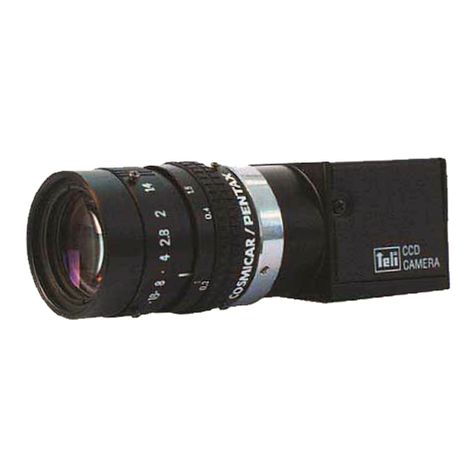
Teli
Teli CS8620i (EIA) User manual

Teli
Teli CS8560D User manual

Teli
Teli CS8550Di User manual
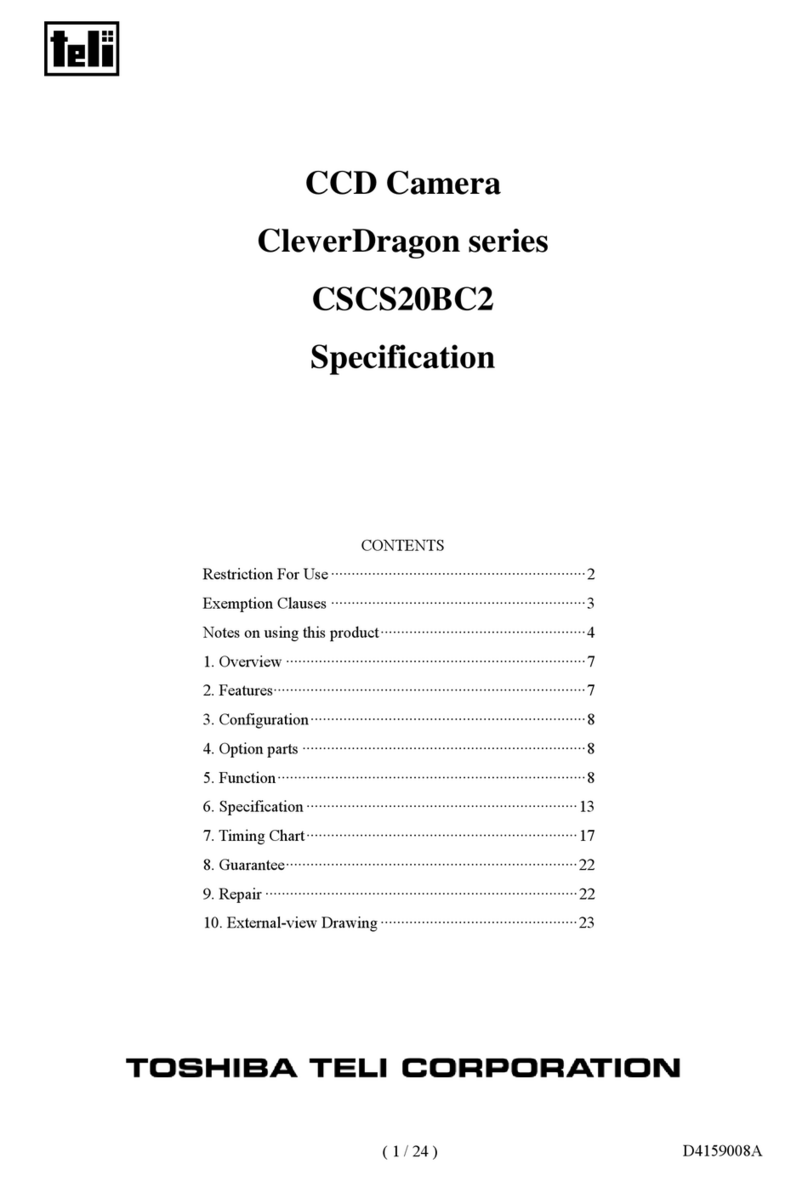
Teli
Teli CSCS20BC2 User manual
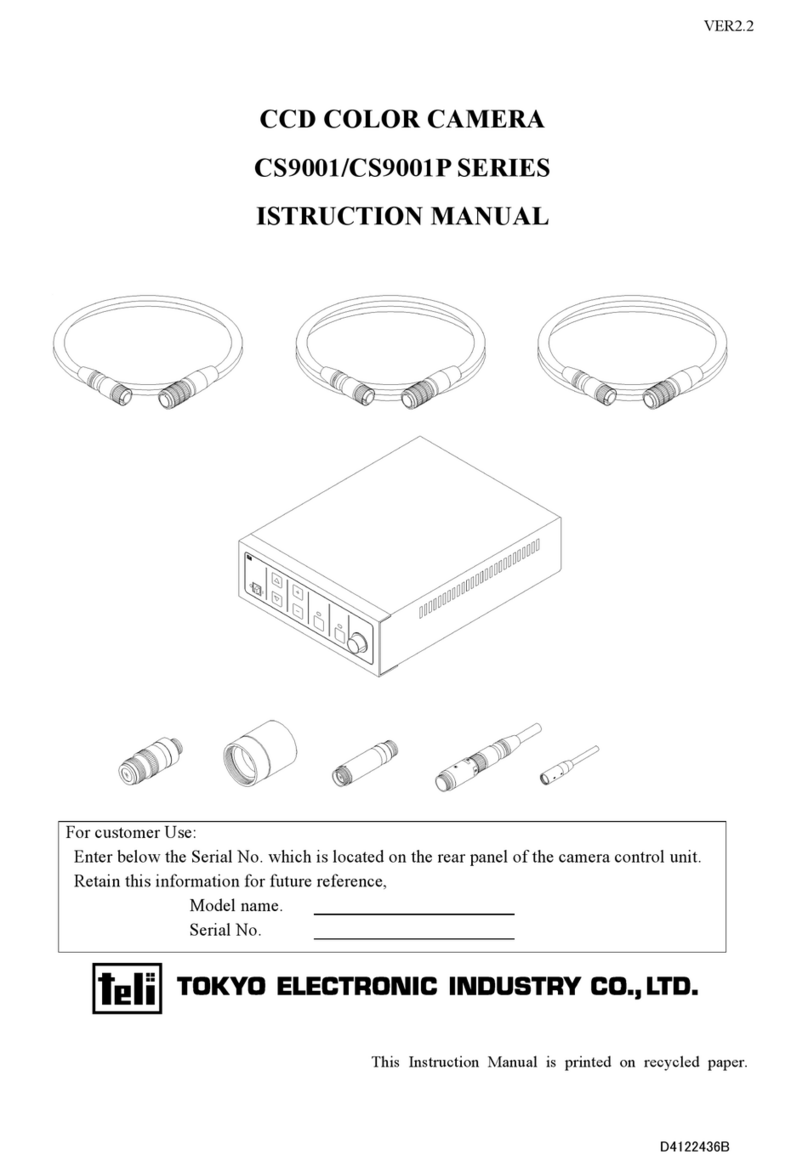
Teli
Teli CS9001 Series User manual
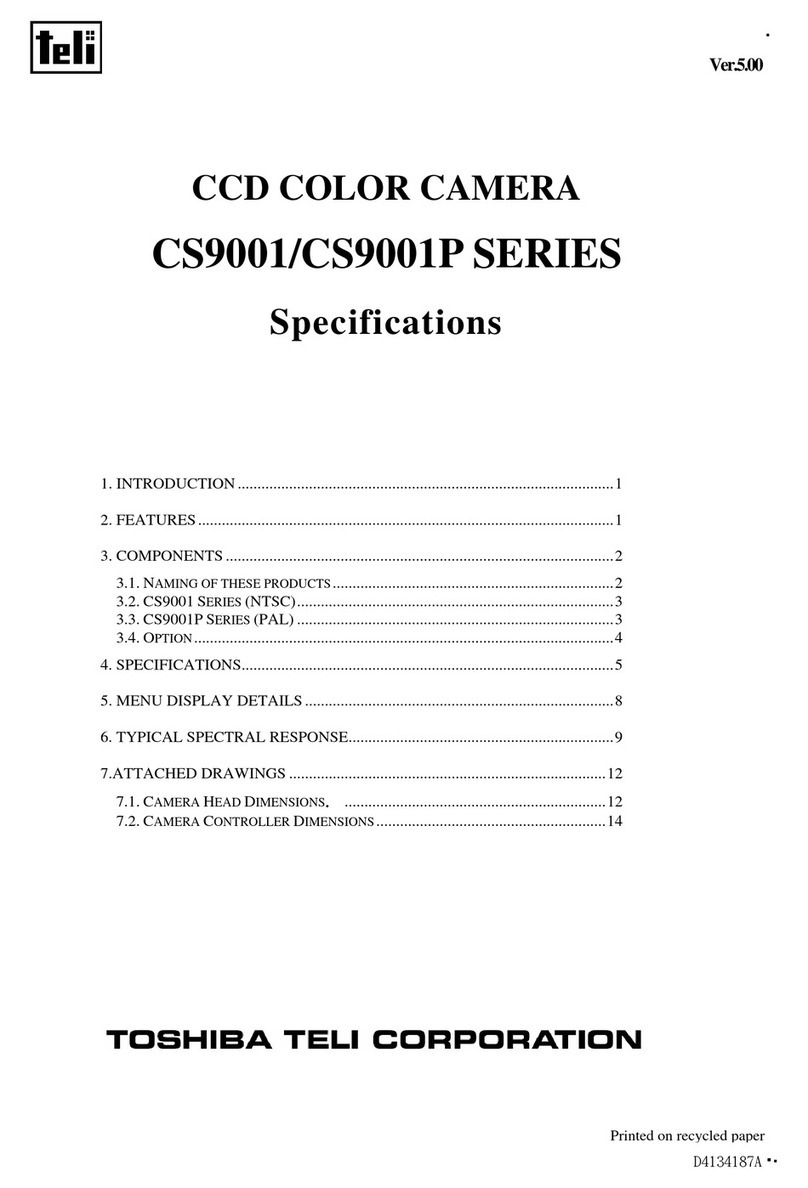
Teli
Teli CS9001 Series User manual
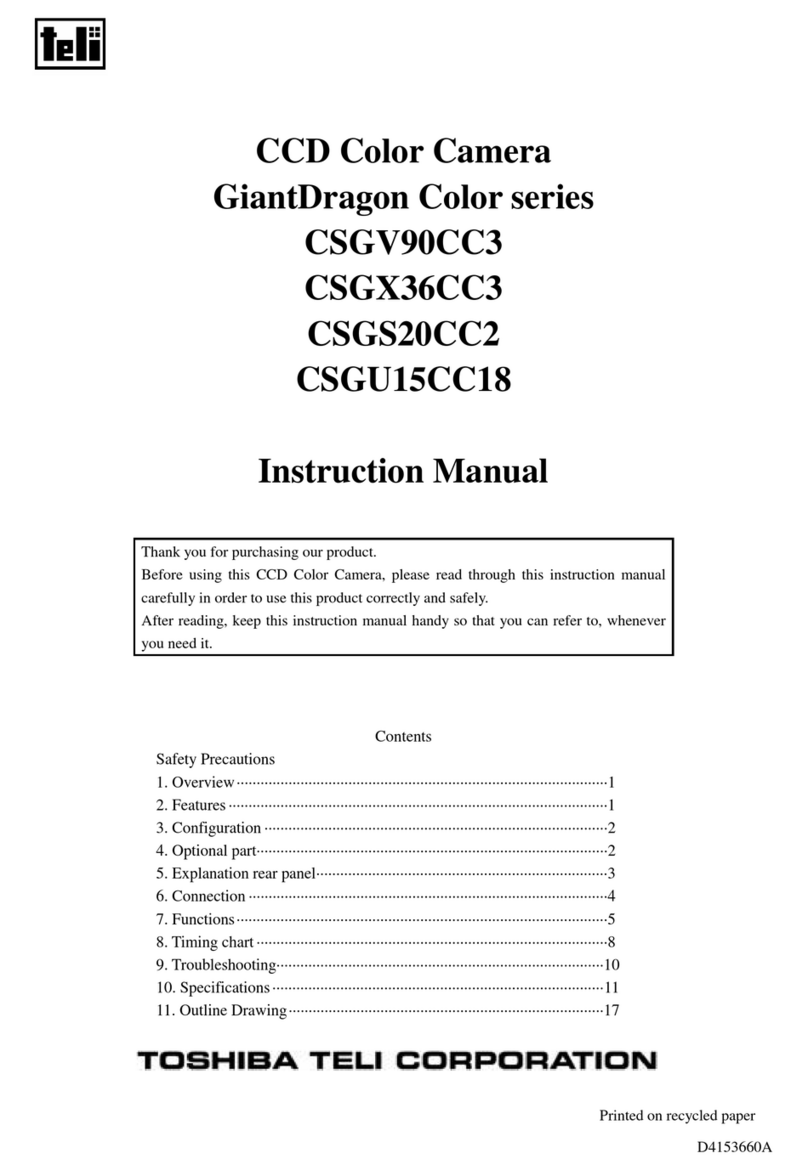
Teli
Teli CGSV90CC3 User manual
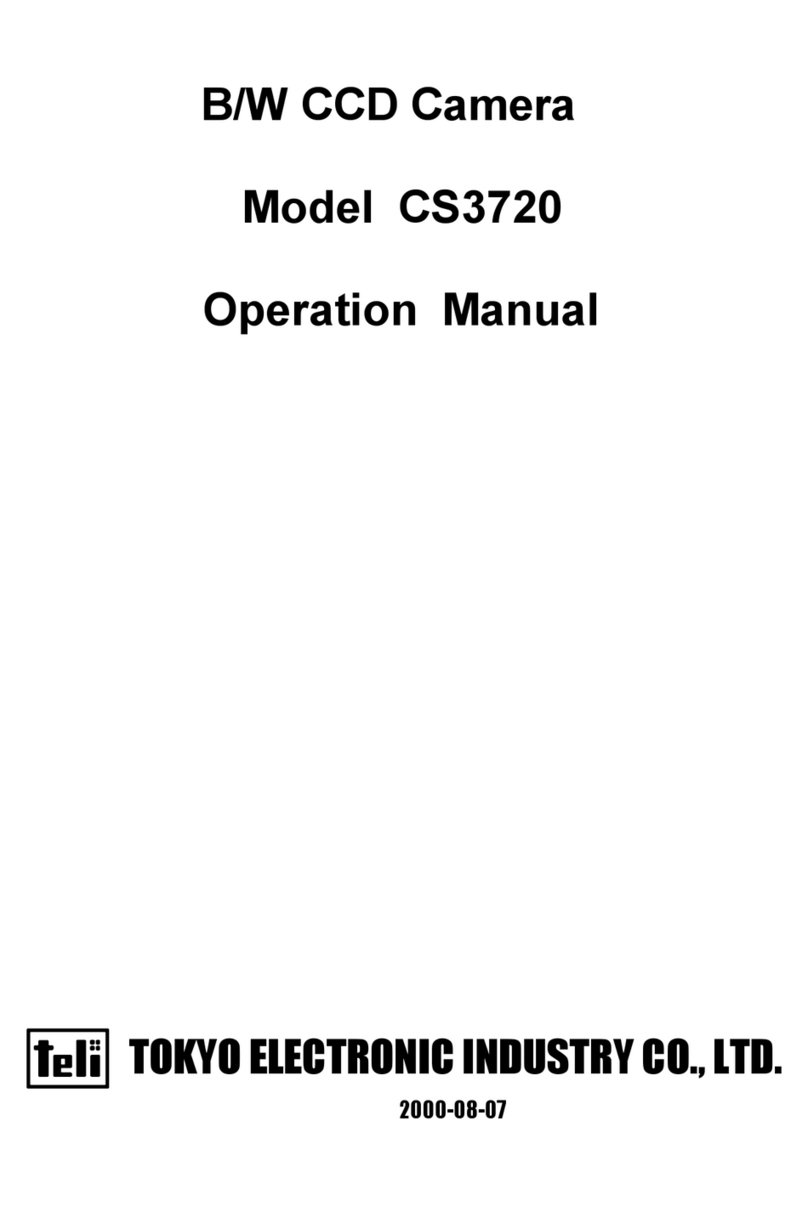
Teli
Teli CS3720 User manual
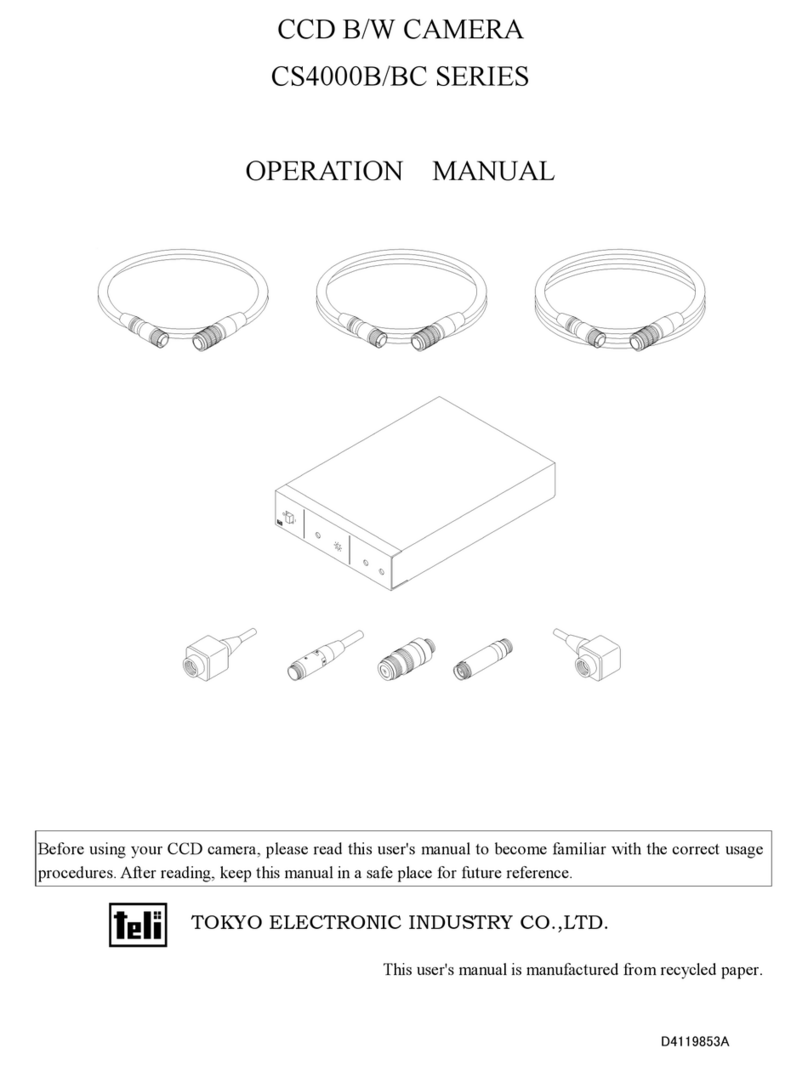
Teli
Teli CS400B series User manual
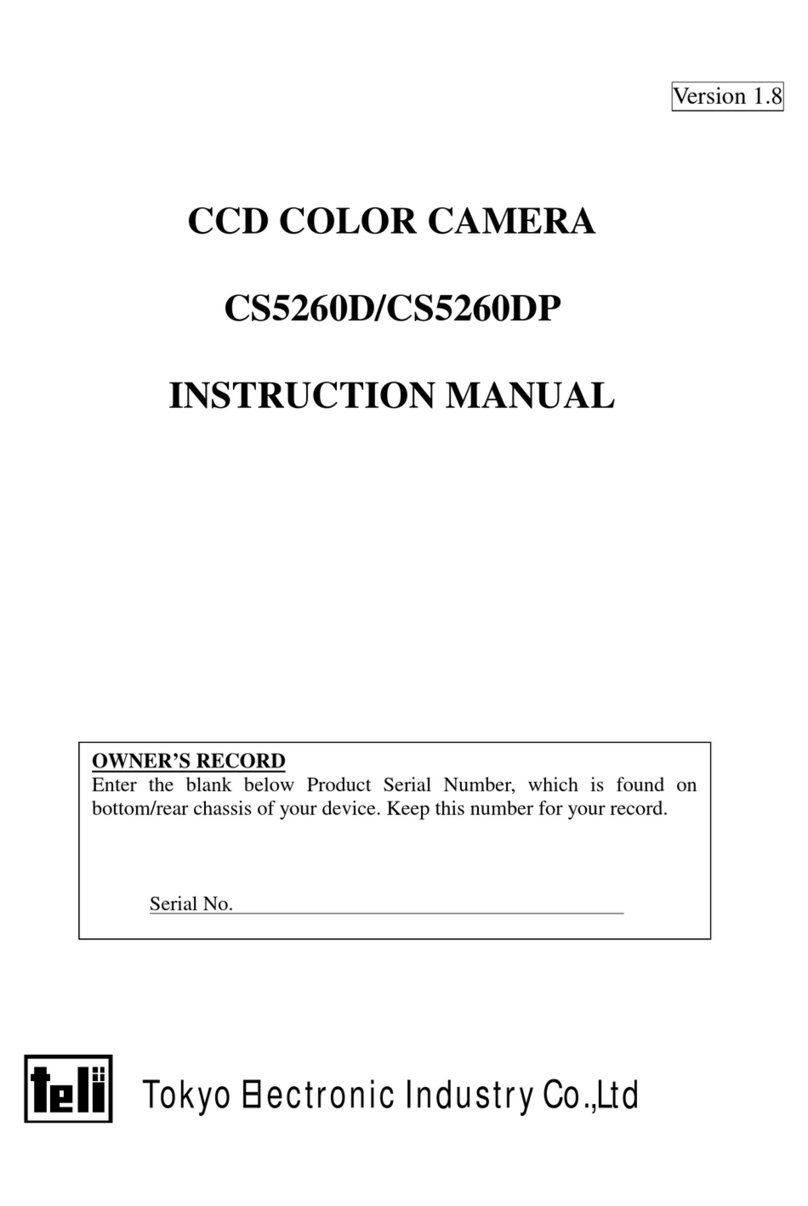
Teli
Teli CS5260D User manual

